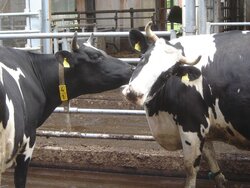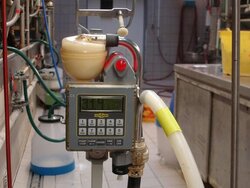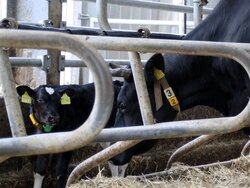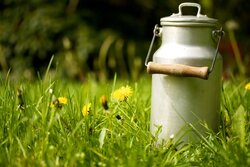Dossier
Keeping cows and calves together
Kerstin Barth | 31.05.2022
It has become a rare sight in modern dairy production systems: cows and their calves together. Usually, they are separated immediately after birth. However, there is another option called cow-calf contact.
More Info
There are two main reasons for the early separation of cow and calf. First, to protect the offspring from pathogens that might be spread by the dam, and second, to prevent the bonding of dam and calf. This bond strengthens during the first days after birth and a later separation would be very stressful for all parties (cow, calf, farmers). On the other hand, early separation means that cows cannot perform natural affiliative behavior towards their calves and therefore the latter lack positive interactions, e.g. licking.
In order to allow the animals to express more normal behaviour, some dairy farms have decided to practice cow- calf contact. In contrast to traditional rearing, where calves are fed milk by humans, cow-calf contact systems allows calves to suckle directly from a cow's udder until weaning, when they are already take in larger amounts of solid feed. The cows continue to be milked. The calves also learn how to deal with other adult animals, for example to avoid aggressive behaviour.
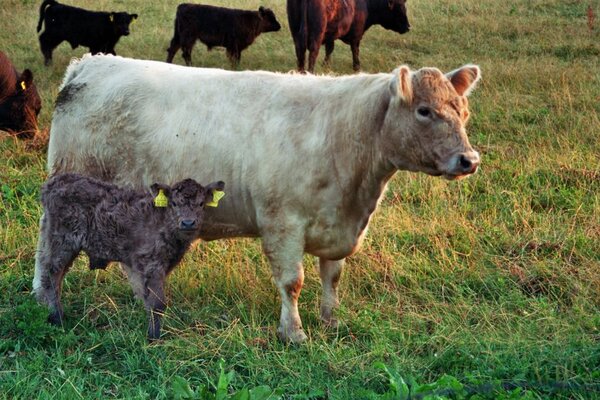
While in dairy farming one speaks of cow-calf contact, the term suckler cow rearing refers to a form of cattle rearing in beef production. Here, beef cattle or crosses are kept extensively on pasture. Cows keep their calves until weaning in the 7th/8th month of age, when the calves are fed mostly solid feed rather than milk. Only then are the young animals separated from their dams and either finished on a fattening farm or are used as mothers. However, the cows are never milked in this system.
In da-calf contact, the calves suckle on their biological mother, while in rearing by foster cows, alien cows take over the rearing. There are also mixed forms in which the calves suckle on their dam and also on foster cows. The overarching term for all of these practices is "cow-calf contact”. Paying attention to the terms is important because the systems can have quite different effects.
Researchers at the Thünen Institute have been working since 2004 on the question of how contact between cow and calf can be enabled under modern husbandry conditions and whether this benefits the animals and the farms. Research is being conducted to determine how this form of rearing affects the health of the calves, the performance of the cows, and also the behaviour of the animals. Many studies have been and are being conducted in cooperation with other research institutions.
In the meantime, the method is becoming more and more popular in practice - especially on organic farms. But cow-calf contact could also be an alternative for conventional farms. Even though some research has already been done - a number of questions are still open. We will address these questions and report research results here on an ongoing basis.
Publications
- 0
Barth K (2020) Effects of suckling on milk yield and milk composition of dairy cows in cow-calf contact systems. J Dairy Res 87(S1):133-137, DOI:10.1017/S0022029920000515
- 1
Sirovnik J, Barth K, de Oliveira D, Ferneborg S, Haskell MJ, Hillmann E, Jensen MB, Mejdell CM, Napolitano F, Vaarst M, Verwer CM, Waiblinger S, Zipp KA, Johnsen JF (2020) Methodological terminology and definitions for research and discussion of cow-calf contact systems. J Dairy Res 87(S1):108-114, DOI:10.1017/S0022029920000564
- 2
de Oliveira D, Barth K, Haskell MJ, Hillmann E, Jensen MB, Johnsen JF, Mejdell CM, Waiblinger S, Ferneborg S (2020) Methodology for experimental and observational animal studies in cow-calf contact systems. J Dairy Res 87(S1):115-121, DOI:10.1017/S0022029920000552
- 3
Waiblinger S, Wagner K, Hillmann E, Barth K (2020) Play and social behaviour of calves with or without access to their dam and other cows. J Dairy Res 87(S1):144-147, DOI:10.1017/S0022029920000540
- 4
Waiblinger S, Wagner K, Hillmann E, Barth K (2020) Short- and long-term effects of rearing dairy calves with contact to their mother on their reactions towards humans. J Dairy Res 87(S1):148-153, DOI:10.1017/S0022029920000576
- 5
Wagner K, Seitner D, Barth K, Palme R, Futschik A, Waiblinger S (2015) Effects of mother versus artificial rearing during the first 12 weeks of life on challenge responses of dairy cows. Appl Anim Behav Sci 164(1):1-11, DOI:10.1016/j.applanim.2014.12.010
- 6
Barth K, Kälber T, Brückmann C, Häußermann A, Waiblinger S (2015) Muttergebundene Kälberaufzucht - mehr lieferbare Milch durch temporären Kalbkontakt? In: Häring AM, Hörning B, Hoffmann-Bahnsen R, Luley H (eds) Beiträge zur 13. Wissenschaftstagung Ökologischer Landbau "Am Mut hängt der Erfolg: Rückblicke und Ausblicke auf die ökologische Landbewirtschaftung". pp 496-497
- 7
Zipp KA, Barth K, Knierim U (2014) Agitation behaviour and heart rate of dairy cows with and without calf-contact during different stimuli in the parlour. Thünen Rep 20, Vol. 2:463-466
- 8
Kälber T, Hechmann T, Häußermann A, Waiblinger S, Barth K (2014) Auswirkungen der Aufzuchtmethode auf die Stressreaktion bei der Eingliederung tragender Färsen in die Milchviehherde. KTBL Schr 505:76-83
- 9
Kälber T, Barth K (2014) Practical implications of suckling systems for dairy calves in organic production systems - a review. Landbauforsch Appl Agric Forestry Res 64(1):45-58, DOI:10.3220/LBF_2014_45-58
https://literatur.thuenen.de/digbib_extern/bitv/dn053878.pdf
- 10
Barth K (2014) Zurück zur Natur?! - viele Fragen und einige Antworten zur muttergebundenen Kälberaufzucht. In: Geßl R (ed) 21. Freiland-Tagung/26. IGN-Tagung : Kurzfassungen der Vorträge an der Universität für Bodenkultur Wien, 25.9.2014. Wien: Freiland Verband, pp 60-64
- 11
Zipp KA, Barth K, Knierim U (2013) Herzfrequenz und Unruheverhalten von Milchkühen mit und ohne Kalbkontakt bei verschiedenen Stimulationen im Melkstand. KTBL Schr 503:198-207
- 12
Zipp KA, Barth K, Knierim U (2013) Milchleistung, Milchfluss und Milchinhaltsstoffe von Kühen mit und ohne Kalbkontakt in Abhängigkeit von verschiedenen Stimulationsverfahren beim Melken. In: Neuhoff D, Stumm C, Ziegler S, Rahmann G, Hamm U, Köpke U (eds) Beiträge zur 12. Wissenschaftstagung Ökologischer Landbau : Ideal und Wirklichkeit: Perspektiven ökologischer Landbewirtschaftung . Berlin: Köster, pp 462-465
- 13
Wagner K, Barth K, Hillmann E, Palme R, Futschik A, Waiblinger S (2013) Mother rearing of dairy calves: Reactions to isolation and to confrontation with an unfamiliar conspecific in a new environment. Appl Anim Behav Sci 147(1-2):43-54, DOI:10.1016/j.applanim.2013.04.010
- 14
Waiblinger S, Wagner K, Hillmann E, Barth K (2013) Spielverhalten und Sozialverhalten von Kälbern bei muttergebundener und mutterloser Aufzucht. KTBL Schr 503:153-159
- 15
Hillmann E, Roth BA, Johns J, Waiblinger S, Barth K (2012) Dam-associated rearing as animal friendly alternative to artificial rearing in dairy cattle. Landbauforsch SH 362:181-183
- 16
Wagner K, Barth K, Palme R, Futschik A, Waiblinger S (2012) Integration into the dairy cow herd: long-term effects of mother contact during the first twelve weeks of life. Appl Anim Behav Sci 141(3-4):117-129, DOI:10.1016/j.applanim.2012.08.011
- 17
Zumbrunnen M, Barth K, Hillmann E (2012) Muttergebundene Kälberaufzucht in der Schweiz. KTBL Schr 496:222-224
- 18
Johns J, Wagner K, Waiblinger S, Barth K, Hillmann E (2011) Hat das Saugen bei der Mutter im Vergleich zum Saugen am Tränkeautomaten für Kälber eine Entspannungswirkung? KTBL Schr 489:88-97
- 19
Wagner K, Barth K, Waiblinger S (2011) Muttergebundene Aufzucht in der Milchviehhaltung - langfristige Auswirkungen auf Verhalten und Wohlbefinden. In: Leithold G, Becker K, Brock C (eds) Beiträge zur 11. Wissenschaftstagung Ökologischer Landbau : Es geht ums Ganze: Forschen im Dialog von Wissenschaft und Praxis : Bd. 2, Tierproduktion und Sozioökonomie. Berlin: Köster, pp 138-139
- 20
Barth K, Wilke K, Haeussermann A, Hillmann E, Waiblinger S (2011) Optimierung der Milchgewinnung in der muttergebundenen Kälberaufzucht - kann der Kalbgeruch helfen? ART SchrR 15:63-66 (ref)
- 21
Wagner K, Barth K, Johns J, Hillmann E, Waiblinger S (2010) Muttergebundene Aufzucht bei Milchviehkälbern: Verhalten bei Konfrontation mit einem fremden Artgenossen in neuer Umgebung. KTBL Schr 482:40-49
- 22
Barth K, Schneider R, Roth BA, Hillmann E (2009) Auswirkungen der muttergebundenen Kälberaufzucht auf das Melkverhalten der Kühe. In: Beiträge zur 10. Wissenschaftstagung Ökologischer Landbau : Werte - Wege - Wirkungen: Biolandbau im Spannungsfeld zwischen Ernährungssicherung, Markt und Klimawandel ; Bd. 2: Tierhaltung, Agrarpolitik und Betriebswirtschaft, Märkte und Lebensmittel. Berlin: Köster, pp 24-27
- 23
Roth BA, Barth K, Gygax L, Hillmann E (2009) Influence of artificial vs. mother-bonded rearing on sucking behaviour, health and weight gain in calves. Appl Anim Behav Sci 119(3-4):143-150, DOI:10.1016/j.applanim.2009.03.004
- 24
Barth K, Roth BA, Hillmann E (2009) Muttergebundene Kälberaufzucht - eine Alternative im Ökologischen Landbau? Landbauforsch SH 326:11-20
- 25
Roth BA, Barth K, Hillmann E (2008) Vergleich der muttergebundenen und der künstlichen Aufzucht bezüglich gegenseitigen Besaugens, Gesundheit und Gewichtsentwicklung bei Kälbern. KTBL Schr 471:108-115
- 26
Schneider RA, Roth BA, Barth K, Hillmann E (2007) Einfluss der muttergebundenen Aufzucht auf Milchleistung, Verhalten im Melkstand und maternales Verhalten behornter Kühe. KTBL Schr 461:48-56
- 27
Barth K, Rademacher C, Georg H (2006) Melken und Kälbersäugen - geht das? Landbauforsch Völkenrode SH 299:77-82

![[Translate to English:] One system – many faces](/media/_processed_/a/c/csm_Ein_System_viele_Gesichter_e6d330cf34.jpg)
